 Lands enrolled in voluntary forest management and conservation programs, like the Forest Stewardship Program, promote good land management practices. In addition to benefiting the landowners enrolled in these programs, good land management provides ecosystem services to society. The Stewardship Ecosystem Services Survey calculated the physical and economic benefits of water resource protection, carbon sequestration and storage, timber production, and wildlife conservation. This 2-page fact sheet was written by Rose Godfrey, Chris Demers, Francisco Escobedo, Damian Adams, and Michael Andreu, and published by the UF Department of School of Forest Resources and Conservation, September 2013.
Lands enrolled in voluntary forest management and conservation programs, like the Forest Stewardship Program, promote good land management practices. In addition to benefiting the landowners enrolled in these programs, good land management provides ecosystem services to society. The Stewardship Ecosystem Services Survey calculated the physical and economic benefits of water resource protection, carbon sequestration and storage, timber production, and wildlife conservation. This 2-page fact sheet was written by Rose Godfrey, Chris Demers, Francisco Escobedo, Damian Adams, and Michael Andreu, and published by the UF Department of School of Forest Resources and Conservation, September 2013.
http://edis.ifas.ufl.edu/fr381
Category: Forest Resources
Thinning Southern Pines – A Key to Greater Returns
 Thinning is an important silvicultural practice that redistributes the growth potential of the site to the best trees. Diameter growth rates are maintained or increased on residual trees after thinning, which increases the return on investment from higher-value trees. Biologically, thinning accelerates stand development by favoring the tallest, best-formed trees over those that are diseased, overtopped, crooked, forked, or otherwise undesirable and likely to die on their own if left in the stand long enough. In addition, thinning provides periodic income, improves access for equipment, recreation and hunting, and creates a generally healthier stand. Thinning is also beneficial for wildlife, especially when combined with prescribed fire or herbicide use to control competing vegetation. By allowing more light to reach the forest floor, thinning promotes growth of plants important as food and/or cover for wildlife species. Landowners are encouraged to consult with or hire a professional forester to assist with thinning and other forest management activities. This 6-page fact sheet was written by Chris Demers, Michael Andreu, Babe McGowan, Alan Long, and Jarek Nowak, and published by the UF Department of School of Forest Resources and Conservation, June 2013.
Thinning is an important silvicultural practice that redistributes the growth potential of the site to the best trees. Diameter growth rates are maintained or increased on residual trees after thinning, which increases the return on investment from higher-value trees. Biologically, thinning accelerates stand development by favoring the tallest, best-formed trees over those that are diseased, overtopped, crooked, forked, or otherwise undesirable and likely to die on their own if left in the stand long enough. In addition, thinning provides periodic income, improves access for equipment, recreation and hunting, and creates a generally healthier stand. Thinning is also beneficial for wildlife, especially when combined with prescribed fire or herbicide use to control competing vegetation. By allowing more light to reach the forest floor, thinning promotes growth of plants important as food and/or cover for wildlife species. Landowners are encouraged to consult with or hire a professional forester to assist with thinning and other forest management activities. This 6-page fact sheet was written by Chris Demers, Michael Andreu, Babe McGowan, Alan Long, and Jarek Nowak, and published by the UF Department of School of Forest Resources and Conservation, June 2013.
http://edis.ifas.ufl.edu/fr159
Herbicides for Weed Control in Eucalyptus Culture
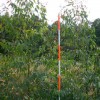 Eucalyptus is a diverse genus with over 700 species, most of which are native to Australia. Numerous Eucalyptus species and hybrid clones have been introduced in temperate climates throughout the world and grown as ornamental trees as well as for fuel and fiber. There is renewed interest in planting this fast-growing tree in the southeastern United States for mulch, pulpwood, and bio-energy. However, several silvicultural challenges exist, and competing vegetation control is a significant one. This 7-page fact sheet was written by Anna Osiecka and Patrick Minogue, and published by the UF Department of School of Forest Resources and Conservation, February 2013.
Eucalyptus is a diverse genus with over 700 species, most of which are native to Australia. Numerous Eucalyptus species and hybrid clones have been introduced in temperate climates throughout the world and grown as ornamental trees as well as for fuel and fiber. There is renewed interest in planting this fast-growing tree in the southeastern United States for mulch, pulpwood, and bio-energy. However, several silvicultural challenges exist, and competing vegetation control is a significant one. This 7-page fact sheet was written by Anna Osiecka and Patrick Minogue, and published by the UF Department of School of Forest Resources and Conservation, February 2013.
http://edis.ifas.ufl.edu/fr378
Cypress looper Anacamptodes pergracilis (Hulst) (Insecta: Lepidoptera: Geometridae) (EENY303/IN986)
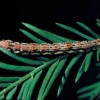 Anacamptodes pergracilis (Hulst), commonly known as the cypress looper, drew considerable attention in late summer of 1980 with the unexpected defoliation of nearly 28,000 ha of cypress trees in USFS-NPS Big Cypress National Preserve (Collier and Monroe counties). Currently, cypress looper populations are at low levels, even in the Fisheating Creek (Glades County) area, a perennial generator of significant cypress looper defoliation over the past 20 years. This 3-page fact sheet was written by Wayne N. Dixon, and published by the UF Department of Entomology and Nematology, April 2013.
Anacamptodes pergracilis (Hulst), commonly known as the cypress looper, drew considerable attention in late summer of 1980 with the unexpected defoliation of nearly 28,000 ha of cypress trees in USFS-NPS Big Cypress National Preserve (Collier and Monroe counties). Currently, cypress looper populations are at low levels, even in the Fisheating Creek (Glades County) area, a perennial generator of significant cypress looper defoliation over the past 20 years. This 3-page fact sheet was written by Wayne N. Dixon, and published by the UF Department of Entomology and Nematology, April 2013.
http://edis.ifas.ufl.edu/in986
Valuing the Ecosystem Services of Florida‹s Forest Conservation Programs: The Economic Benefits of Protecting Water Quality (FOR309/FR377)
 How much are Floridians willing to pay for water quality protection programs that include forest conservation? This 9-page fact sheet reports the results of a study to answer this question, using a benefit transfer approach. Written by Melissa M. Kreye, Francisco J. Escobedo, Damian C. Adams, Taylor Stein, and Tatiana Borisova, and published by the UF Department of School of Forest Resources and Conservation, April 2013.
How much are Floridians willing to pay for water quality protection programs that include forest conservation? This 9-page fact sheet reports the results of a study to answer this question, using a benefit transfer approach. Written by Melissa M. Kreye, Francisco J. Escobedo, Damian C. Adams, Taylor Stein, and Tatiana Borisova, and published by the UF Department of School of Forest Resources and Conservation, April 2013.
http://edis.ifas.ufl.edu/fr377
Common Woody Plants of Florida Scrub Ecosystems (FOR305/FR373)
 The purpose of this fact sheet is to help identify a few of the more common woody plant species found in Florida’s scrub ecosystems. In the individual plant descriptions, words that appear in bold font are considered to be key field characteristics that will aid in identification of the species. This 14-page fact sheet was written by Lynn Proenza and Michael Andreu, and published by the UF Department of School of Forest Resources and Conservation, October 2012.
The purpose of this fact sheet is to help identify a few of the more common woody plant species found in Florida’s scrub ecosystems. In the individual plant descriptions, words that appear in bold font are considered to be key field characteristics that will aid in identification of the species. This 14-page fact sheet was written by Lynn Proenza and Michael Andreu, and published by the UF Department of School of Forest Resources and Conservation, October 2012.
http://edis.ifas.ufl.edu/fr373
Key to Nine Common Smilax Species of Florida (FOR307/FR375)
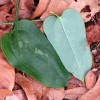 Identifying species found in Smilax the genus can be difficult because species resemble one another closely. One must be careful to use detailed descriptions in order to correctly identify a specimen. Smilax species are important because they can provide shelter and food for wildlife and have provided humans with medicine, food, and dyes. Twelve Smilax species are found in Florida. This 8-page fact sheet covers the nine more common species that one may encounter in the state. Written by Lynn Proenza and Michael Andreu, and published by the UF Department of School of Forest Resources and Conservation, January 2013.
Identifying species found in Smilax the genus can be difficult because species resemble one another closely. One must be careful to use detailed descriptions in order to correctly identify a specimen. Smilax species are important because they can provide shelter and food for wildlife and have provided humans with medicine, food, and dyes. Twelve Smilax species are found in Florida. This 8-page fact sheet covers the nine more common species that one may encounter in the state. Written by Lynn Proenza and Michael Andreu, and published by the UF Department of School of Forest Resources and Conservation, January 2013.
http://edis.ifas.ufl.edu/fr375
Thousand Cankers Disease: A Threat to Black Walnut in Florida (FOR308/FR376)
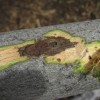 Thousand cankers disease of walnut is a tree disease of the edible nut-producing and ornamental tree, black walnut. The first diseased trees were observed in New Mexico in the 1990s. The disease has since spread to most of the western states. Until 2009, diseased black walnut trees were only found outside of the natural range of black walnut, which occurs from the mid-Atlantic states to just west of the Mississippi River. In 2009, it was found near Knoxville, Tennessee; it has since spread to Pennsylvania and Virginia. It is possible that within the next decade this disease could naturally spread to Florida. However, if people continue to move TCD infested walnut logs from place to place, this disease could arrive in Florida tomorrow. This 3-page fact sheet was written by Don Spence and Jason A. Smith, and published by the UF Department of School of Forest Resources and Conservation, February 2013.
Thousand cankers disease of walnut is a tree disease of the edible nut-producing and ornamental tree, black walnut. The first diseased trees were observed in New Mexico in the 1990s. The disease has since spread to most of the western states. Until 2009, diseased black walnut trees were only found outside of the natural range of black walnut, which occurs from the mid-Atlantic states to just west of the Mississippi River. In 2009, it was found near Knoxville, Tennessee; it has since spread to Pennsylvania and Virginia. It is possible that within the next decade this disease could naturally spread to Florida. However, if people continue to move TCD infested walnut logs from place to place, this disease could arrive in Florida tomorrow. This 3-page fact sheet was written by Don Spence and Jason A. Smith, and published by the UF Department of School of Forest Resources and Conservation, February 2013.
http://edis.ifas.ufl.edu/fr376
Natural Area Weeds: Old World Climbing Fern (Lygodium microphyllum) (SSAGR21/AG122)
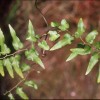 Native to Africa, Asia, and Australia, Old World climbing fern (OWCF) is a newcomer to Florida that has spread at an alarming rate since its introduction. The Florida Exotic Pest Plant Council considers Old World climbing fern to be invasive. It’s also regulated by laws of the Florida Department of Agriculture and Consumer Services (FDACS) as a Florida Noxious Weed and by the United States Department of Agriculture (USDA) as a Federal Noxious Weed. It may be the most serious threat to Florida’s natural areas. This 6-page fact sheet was written by Kenneth A. Langeland and Jeffery Hutchinson, and published by the UF Department of Agronomy, February 2013.
Native to Africa, Asia, and Australia, Old World climbing fern (OWCF) is a newcomer to Florida that has spread at an alarming rate since its introduction. The Florida Exotic Pest Plant Council considers Old World climbing fern to be invasive. It’s also regulated by laws of the Florida Department of Agriculture and Consumer Services (FDACS) as a Florida Noxious Weed and by the United States Department of Agriculture (USDA) as a Federal Noxious Weed. It may be the most serious threat to Florida’s natural areas. This 6-page fact sheet was written by Kenneth A. Langeland and Jeffery Hutchinson, and published by the UF Department of Agronomy, February 2013.
http://edis.ifas.ufl.edu/ag122
Wildland-Urban Interface: Key Issues (FOR202/FR264)
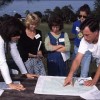 A result of the influx of new residents to the South is an expansion of urban areas into forests and other natural areas, creating areas referred to as the wildland-urban interface. Interface issues of most concern vary from state to state, but some key issues are consistent across the South. the US Forest Service conducted a series of focus groups in 2000. Key issues gleaned from those focus groups and other related sources are described in this 5-page fact sheet written by L. Annie Hermansen-Baez, Jennifer Seitz, and Martha C. Monroe, and published by the UF Department of School of Forest Resources and Conservation, February 2013.
A result of the influx of new residents to the South is an expansion of urban areas into forests and other natural areas, creating areas referred to as the wildland-urban interface. Interface issues of most concern vary from state to state, but some key issues are consistent across the South. the US Forest Service conducted a series of focus groups in 2000. Key issues gleaned from those focus groups and other related sources are described in this 5-page fact sheet written by L. Annie Hermansen-Baez, Jennifer Seitz, and Martha C. Monroe, and published by the UF Department of School of Forest Resources and Conservation, February 2013.
http://edis.ifas.ufl.edu/fr264
Tropical Soda Apple Leaf Beetle, Gratiana boliviana Spaeth (Insecta: Coleoptera: Chrysomelidae: Cassidinae) (EENY543/IN974)
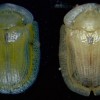 Tropical soda apple is a prickly shrub native to South America that is a major problem in pastures and conservation areas. So a multi-agency program supported the rearing, distribution, and release of more than 250,000 tropical soda apple leaf beetles across Florida from 2003 to 2011. This 4-page fact sheet was written by Rodrigo Diaz, William A. Overholt, Ken Hibbard, and Julio Medal, and published by the UF Department of Entomology and Nematology, January 2013.
Tropical soda apple is a prickly shrub native to South America that is a major problem in pastures and conservation areas. So a multi-agency program supported the rearing, distribution, and release of more than 250,000 tropical soda apple leaf beetles across Florida from 2003 to 2011. This 4-page fact sheet was written by Rodrigo Diaz, William A. Overholt, Ken Hibbard, and Julio Medal, and published by the UF Department of Entomology and Nematology, January 2013.
http://edis.ifas.ufl.edu/in974
Natural Area Weeds: Skunkvine (Paederia foetida) (SSAGR80/WG208)
 Native to eastern and southern Asia, skunkvine is an invasive plant species introduced to the USDA Field Station near Brooksville before 1897. It has been included on the Florida Exotic Pest Plant Council List of Invasive Species as a Category I, defined as “species that are invading and disrupting native plant communities in Florida.” It was added to the Florida Noxious Weed List in 1999, making it illegal to possess, move, or release in Florida. This 3-page fact sheet was written by K. A. Langeland, R. K. Stocker, and D. M. Brazis, and published by the UF Department of Agronomy, February 2013.
Native to eastern and southern Asia, skunkvine is an invasive plant species introduced to the USDA Field Station near Brooksville before 1897. It has been included on the Florida Exotic Pest Plant Council List of Invasive Species as a Category I, defined as “species that are invading and disrupting native plant communities in Florida.” It was added to the Florida Noxious Weed List in 1999, making it illegal to possess, move, or release in Florida. This 3-page fact sheet was written by K. A. Langeland, R. K. Stocker, and D. M. Brazis, and published by the UF Department of Agronomy, February 2013.
http://edis.ifas.ufl.edu/wg208
Tips for Integrating Land and Wildlife Management: Deer in Forests (WEC329/UW374)
 Prized by hunters and wildlife enthusiasts alike, white-tailed deer are a popular species found throughout Florida. As such, they are often the focus of management for landowners, managers, and lessees who want to improve deer populations while maintaining other land uses such as timber production. This 2-page fact sheet provides some deer habitat improvement tips that focus primarily on raising the quality of deer forage but that also will help you grow better cover by improving plant diversity and productivity. Written by William M. Giuliano, John M. Olson, and Cailey Thomas, and published by the UF Department of Wildlife Ecology and Conservation, January 2013.
Prized by hunters and wildlife enthusiasts alike, white-tailed deer are a popular species found throughout Florida. As such, they are often the focus of management for landowners, managers, and lessees who want to improve deer populations while maintaining other land uses such as timber production. This 2-page fact sheet provides some deer habitat improvement tips that focus primarily on raising the quality of deer forage but that also will help you grow better cover by improving plant diversity and productivity. Written by William M. Giuliano, John M. Olson, and Cailey Thomas, and published by the UF Department of Wildlife Ecology and Conservation, January 2013.
http://edis.ifas.ufl.edu/uw374
Tips for Integrating Land and Wildlife Management: Quail and Timber (WEC331/UW376)
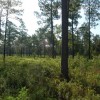 In Florida, changes in forest management practices during the past 50+ years have led to declines in quail habitat and populations. Important changes involve the use of fire and conversion of native forests to commercial pine plantations. A lack of fire and other disturbance has often led to closed-canopy forests with dense undergrowth that lack important quail habitat components. This 2-page fact sheet provides several quail habitat improvement tips that focus on diversifying the plant species and structural composition and increasing early successional communities dominated by herbaceous plants. Written by William M. Giuliano and Lauren Watine, and published by the UF Department of Wildlife Ecology and Conservation, January 2013.
In Florida, changes in forest management practices during the past 50+ years have led to declines in quail habitat and populations. Important changes involve the use of fire and conversion of native forests to commercial pine plantations. A lack of fire and other disturbance has often led to closed-canopy forests with dense undergrowth that lack important quail habitat components. This 2-page fact sheet provides several quail habitat improvement tips that focus on diversifying the plant species and structural composition and increasing early successional communities dominated by herbaceous plants. Written by William M. Giuliano and Lauren Watine, and published by the UF Department of Wildlife Ecology and Conservation, January 2013.
http://edis.ifas.ufl.edu/uw376
Air Potato Leaf Beetle (Suggested Common Name), Lilioceris cheni Gressitt and Kimoto (Insecta: Coleoptera: Chrysomelidae: Criocerinae) (EENY547/IN972)
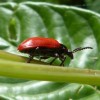 This leaf feeding beetle was recently introduced into Florida from China for biological control of air potato. This 4-page fact sheet provides information on the distribution, appearance, life cycle, host range and importance of the beetle. Written by Entomology and Nematology, and published by the UF Department of Ted D. Center and William A. Overholt, January 2013.
This leaf feeding beetle was recently introduced into Florida from China for biological control of air potato. This 4-page fact sheet provides information on the distribution, appearance, life cycle, host range and importance of the beetle. Written by Entomology and Nematology, and published by the UF Department of Ted D. Center and William A. Overholt, January 2013.
http://edis.ifas.ufl.edu/in972
Classical Biological Control of Tropical Soda Apple with Gratiana boliviana (ENY865/IN971)
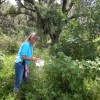 Tropical soda apple is a prickly shrub native to South America. First reported in Glades Co., Florida in 1988, it later spread to Georgia, Alabama, Louisiana, Texas, Mississippi, Tennessee, North Carolina, and South Carolina. It is a major problem in pastures and conservation areas. Negative impacts of tropical soda apple include reduction of cattle stocking rates, competition with native plants, and the costs associated with its control. Dense thickets of the weed also can disrupt the movement of wildlife. This 4-page fact sheet provides a summary of the major steps of the successful biological control program against tropical soda apple in Florida. The article covers the importance of the weed, identification and biology of the biological control agent, rearing and release efforts, establishment and impact, and efforts to communicate the outcomes of the program to stakeholders. Written by R. Diaz, J. Medal, K. Hibbard, A. Roda, A. Fox, S. Hight, P. Stansly, B. Sellers, J. Cuda and W. A. Overholt, and published by the UF Department of Entomology and Nematology, November 2012.
Tropical soda apple is a prickly shrub native to South America. First reported in Glades Co., Florida in 1988, it later spread to Georgia, Alabama, Louisiana, Texas, Mississippi, Tennessee, North Carolina, and South Carolina. It is a major problem in pastures and conservation areas. Negative impacts of tropical soda apple include reduction of cattle stocking rates, competition with native plants, and the costs associated with its control. Dense thickets of the weed also can disrupt the movement of wildlife. This 4-page fact sheet provides a summary of the major steps of the successful biological control program against tropical soda apple in Florida. The article covers the importance of the weed, identification and biology of the biological control agent, rearing and release efforts, establishment and impact, and efforts to communicate the outcomes of the program to stakeholders. Written by R. Diaz, J. Medal, K. Hibbard, A. Roda, A. Fox, S. Hight, P. Stansly, B. Sellers, J. Cuda and W. A. Overholt, and published by the UF Department of Entomology and Nematology, November 2012.
http://edis.ifas.ufl.edu/in971
Classical Biological Control of Air Potato in Florida (ENY864/IN957)
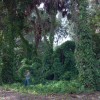 Air potato was introduced to Florida in 1905. By the 1980s, its vines were growing in thickets, waste areas, and hedges or fencerows in many parts of south and central Florida. By 1999, it was recognized as transforming plant communities by displacing native species, changing community structure and disrupting ecological functions. The air potato leaf beetle is a rather large, orange-red Asian leaf beetle. It feeds and develops only on air potato. The USDA-ARS Invasive Plant laboratory in Fort Lauderdale acquired this beetle from China and has begun an ambitious release program aimed at controlling air potato. This 3-page fact sheet was written by T. D. Center and W. A. Overholt, and published by the UF Department of Entomology and Nematology, October 2012.
Air potato was introduced to Florida in 1905. By the 1980s, its vines were growing in thickets, waste areas, and hedges or fencerows in many parts of south and central Florida. By 1999, it was recognized as transforming plant communities by displacing native species, changing community structure and disrupting ecological functions. The air potato leaf beetle is a rather large, orange-red Asian leaf beetle. It feeds and develops only on air potato. The USDA-ARS Invasive Plant laboratory in Fort Lauderdale acquired this beetle from China and has begun an ambitious release program aimed at controlling air potato. This 3-page fact sheet was written by T. D. Center and W. A. Overholt, and published by the UF Department of Entomology and Nematology, October 2012.
http://edis.ifas.ufl.edu/in957
The Costs of Managing an Urban Forest (FOR217/FR279)
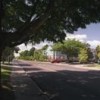 Urban forests provide benefits to society often referred to as ecosystem services: they improve human health, environmental quality, and local economies by increasing property values and aesthetics in communities. They help cities control storm water, reduce air pollution and energy costs, and offset carbon dioxide emissions. But urban forests also have “ecosystem disservices.” An accurate assessment of an urban forest’s costs can assist decision makers to better understand the role the forest plays in improving the well-being of the community. Identifying how funding is used can also help communities minimize costs and increase benefits. This 4-page fact sheet will review some of the types of costs associated with urban forests and present typical financial costs associated with urban forest management in the city of Gainesville, Florida. Written by Francisco Escobedo and Jennifer Seitz, and published by the UF Department of School of Forest Resources and Conservation, October 2012.
Urban forests provide benefits to society often referred to as ecosystem services: they improve human health, environmental quality, and local economies by increasing property values and aesthetics in communities. They help cities control storm water, reduce air pollution and energy costs, and offset carbon dioxide emissions. But urban forests also have “ecosystem disservices.” An accurate assessment of an urban forest’s costs can assist decision makers to better understand the role the forest plays in improving the well-being of the community. Identifying how funding is used can also help communities minimize costs and increase benefits. This 4-page fact sheet will review some of the types of costs associated with urban forests and present typical financial costs associated with urban forest management in the city of Gainesville, Florida. Written by Francisco Escobedo and Jennifer Seitz, and published by the UF Department of School of Forest Resources and Conservation, October 2012.
http://edis.ifas.ufl.edu/fr279
Using Soils to Guide Fertilizer Recommendations for Southern Pines (CIR1230/FR053)
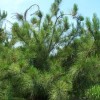 Soils supporting southern pine stands in the South tend to be infertile and nutrient additions are often required to achieve optimum rates of production. This 12-page publication describes and classifies soils of the southeastern Coastal Plain region and specifically addresses issues of fertility, growth-limiting nutrients, and fertilizer recommendations for southern pines. Written by Eric J. Jokela and Alan J. Long, and published by the UF Department of School of Forest Resources and Conservation, June 2012.
Soils supporting southern pine stands in the South tend to be infertile and nutrient additions are often required to achieve optimum rates of production. This 12-page publication describes and classifies soils of the southeastern Coastal Plain region and specifically addresses issues of fertility, growth-limiting nutrients, and fertilizer recommendations for southern pines. Written by Eric J. Jokela and Alan J. Long, and published by the UF Department of School of Forest Resources and Conservation, June 2012.
http://edis.ifas.ufl.edu/fr053
Controlling Invasive Exotic Plants in North Florida Forests (SSFOR19/FR133)
 Invasive non-native organisms are one of the greatest threats to the natural ecosystems of the United States. Invasive plants reduce biodiversity, encroach on endangered and threatened species, and rob native species of habitat. This 8-page fact sheet describes many of the current methods used to manage some of the more common and troublesome invasive exotic plants in north Florida forests. Written by Chris Demers, Alan Long and Rick Williams, and published by the UF Department of School of Forest Resources and Conservation, January 2012.
Invasive non-native organisms are one of the greatest threats to the natural ecosystems of the United States. Invasive plants reduce biodiversity, encroach on endangered and threatened species, and rob native species of habitat. This 8-page fact sheet describes many of the current methods used to manage some of the more common and troublesome invasive exotic plants in north Florida forests. Written by Chris Demers, Alan Long and Rick Williams, and published by the UF Department of School of Forest Resources and Conservation, January 2012.
http://edis.ifas.ufl.edu/fr133